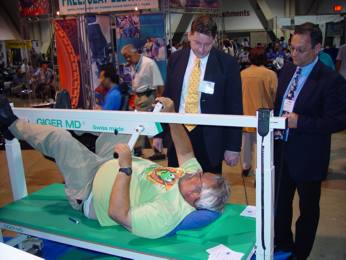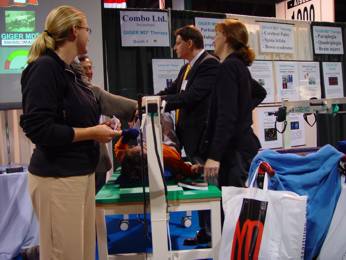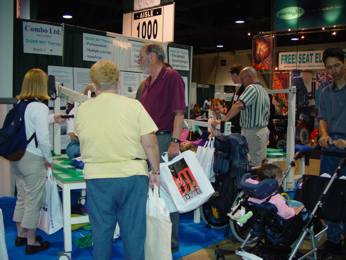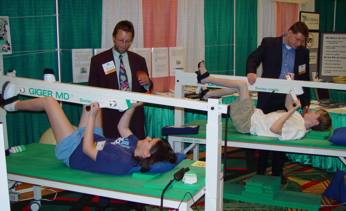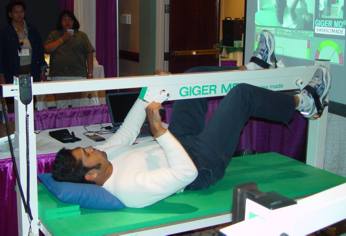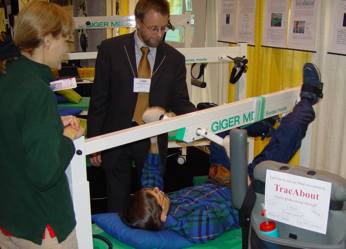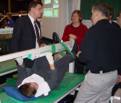Therapy of Stroke
New learning therapy for stroke patients which gives you at least twice as much success as standard therapies, and works even in hopeless cases.
Explore on these sites how you can use and profit from this new learning therapy and its rehab program.
New successful possibility of recovery for patients with brain stroke, brain injury, spinal cord lesions, or other diseases affecting the Central Nervous System (CNS)
 Original
CNS
Original
CNS
GIGER MD ® therapy is the new efficient method for treating patients with lesions or diseases affecting the Central Nervous System (CNS). This method is rehabilitating the CNS, unlike many other methods which affect only the periphery. Moreover the mobility of people with stroke can be improved at the same time through the GIGER MD ® medical device with great success.
Groups of patients suitable for this therapy are:
- Stroke / Apoplexia
- Brain injury / lesion
- Paraplegia / Quadriplegia; spinal cord lesion
- Cerebral Palsy
- Parkinson’s Disease
- Other diseases affecting the CNS
Basis for the GIGER MD ® therapy
The GIGER MD therapy is used to treat patients with CNS lesions.
Due to the 4 new developments in human neurophysiology mentioned below, it is possible to reorganize the lesioned or functionally impaired human central nervous system (CNS). The 4 new repair-related concepts are:
1. The CNS is viewed as a neuronal network which organizes itself. The organization can be changed by re-learning.
2. The self-organization is based on a relative (specifically changing) phase- and frequency coordination of rhythmically firing sub neuronal networks and single neurons.
3. Neurogenesis and functional cell proliferation is induced and controlled by learning. Methods for re-learning basic CNS functions use especially rhythmic, dynamic, coordinated movements (GIGER MD ® medical device).
4. It seems from the success in re-learning movements, vegetative and higher mental functions in patients with CNS lesion that the human CNS has a second integrative strategy to learn, re-learn, store and recall network states.
Theory of coordination dynamics of the lesioned human CNS and re-learning
The lesioned human CNS can be repaired by re-learning of partially lost phase and frequency coordination through coordinated rhythmic movements. The severely lesioned CNS can only efficiently be repaired if integrative, coordinated functions are re-learned. The re-learning of relative phase and frequency coordination of the lesioned CNS can be achieved by:
1. Using the special coordination dynamic therapy device GIGER MD â which offer exact phase and frequency coordination up to a few milliseconds for re-learning.
2. The training of automatisms, postures and old learned movements which are only little impaired in their functioning by the lesion.
Rather than asking what is the best method to re-organize the lesioned CNS we should ask what method is most efficient in re-organizing the lesioned CNS by re-learning. The increase of the rate of re-learning is determined by 4 factors:
1. The exactness of the coordination of the performed movements during the therapy, to functionally reconnect disconnected network parts to recouple arms or legs that cannot be moved.
2. The increase of the intergrativity of the coordination dynamic therapy, which increases the number and complexity of simultaneously exercised phase and frequency coordinations and makes it possible to re-learn integrative functions such as the higher mental functions.
3. The enhancement of the movement induced re-afferent input to strengthen the physiologic self-organization of the lesioned CNS and its communication with the environment.
4. The increase of the intensity of the therapy to force the “adaptive machine” CNS to adapt.
Because of measured phase and frequency coordination in the process of neuronal network organization in man, the theory of coordination dynamics is used for re-learning motor, vegetative, and higher mental functions. The re-learning (repair) is seen as a change of the existing inner coordination dynamics tendencies after the lesion (with no or only pathologic functioning of arms, legs and trunk) to achieve CNS coordination dynamics which will generate again physiologic movements, vegetative and higher mental functions.
The change of the coordination dynamics is achieved by the coordination dynamic therapy, especially by the GIGER MD â medical device.
The improvement of the coordinated movement of an arm, finger or leg can be measured. The improvement of the average coordination dynamics when exercising on the special coordination dynamic therapy device can be used to quantify the improvement of the inner coordination tendencies on the macroscopic level.
Rehabilitation with GIGER MD
® TherapyUnfortunately, a lacking or delayed diagnosis of
infantile apoplectic stroke often sets back the start
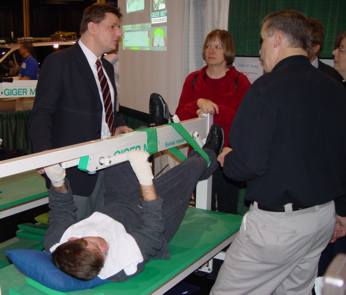 of efficient therapy
with GIGER MD® therapy instruments. In the case
of elderly people who have been diagnosed with an apoplexia, physicians and
therapists keep pointing out the value of intense rehabilitative measures
such as GIGER MD® Therapy, among others. Of
course, the same holds for children, but as long as the disorder remains
unnoticed, they do not get sufficient therapy to recover lost functions.
of efficient therapy
with GIGER MD® therapy instruments. In the case
of elderly people who have been diagnosed with an apoplexia, physicians and
therapists keep pointing out the value of intense rehabilitative measures
such as GIGER MD® Therapy, among others. Of
course, the same holds for children, but as long as the disorder remains
unnoticed, they do not get sufficient therapy to recover lost functions.
Whether young or old, whoever has suffered an
apoplectic stroke has to intensely exercise his mobility. Depending on where
exactly in the brain the circulatory disorder has occurred, there are losses
that impact on the patient’s speech, visual ability or motoricity. Even if a
large number of nerve cells have been irretrievably destroyed,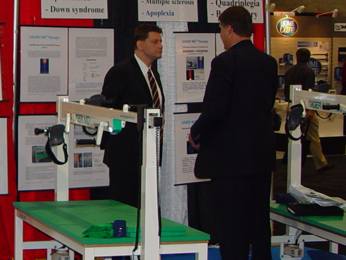 healthy areas
of the brain can take over new functions if they are stimulated through
intense exercise. With the help of GIGER MD®
Therapy patients learn to recover lost functions. Coordinated motor
training cannot be replaced by any medicament according to – among others –
Dr. Karl-Heinz Mauritz, professor of neurological rehabilitation at the
Berlin Clinic. He claims that for the learning or relearning respectively,
of motor skills after an apoplectic stroke, the same principle holds as for
a pianist. Each single movement has to be exercised a thousand times till it
is perfect. GIGER MD® Therapy fully meets these
demands.
healthy areas
of the brain can take over new functions if they are stimulated through
intense exercise. With the help of GIGER MD®
Therapy patients learn to recover lost functions. Coordinated motor
training cannot be replaced by any medicament according to – among others –
Dr. Karl-Heinz Mauritz, professor of neurological rehabilitation at the
Berlin Clinic. He claims that for the learning or relearning respectively,
of motor skills after an apoplectic stroke, the same principle holds as for
a pianist. Each single movement has to be exercised a thousand times till it
is perfect. GIGER MD® Therapy fully meets these
demands.
The earlier rehabilitation with GIGER MD® Therapy begins the better. The necessity of a long-term rehabilitation depends on the gravity of the individual nerve damage. Some patients soon recover fully, others sometimes take months or years to regain complete control over daily activities.
The success of rehabilitation measures depends on a number of factors, such as the gravity of brain damage, the patient’s discipline, the quality of therapy and the support as well as help of family and friends. However, every patient benefits from GIGER MD® Therapy and apoplectic stroke patients’ opportunities of recovery are therefore better today than ever before.
The results of scientific studies have clearly shown that patients who begin intense GIGER MD® Therapy at an early stage – after an apoplectic stroke caused by hypoperfusion – recover faster and show comparatively less lasting damage than patients who have not undergone this therapy.
However difficult the state of the person affected may be at first: in the course of GIGER MD® Therapy great progress is possible. And even later on, intense and continuous therapy can result in improvement deemed impossible at the outset.
GIGER MD® has over 20 years of experience in research and development of new rehab and therapy programs worldwide!
Last update: October 28, 2007
Original CNS
Los Angeles,
California
Los Angeles,
California
Los Angeles,
California
Orlando,
Florida
Phoenix,
Arizona
San Francisco,
California
New York
Atlanta, Giorgia

